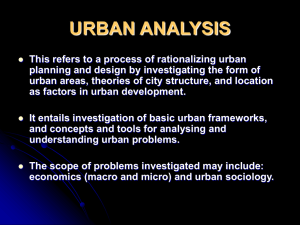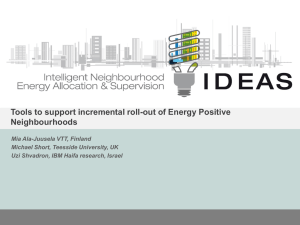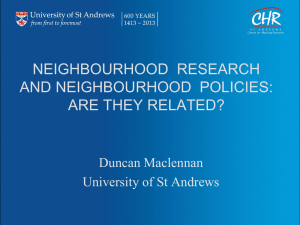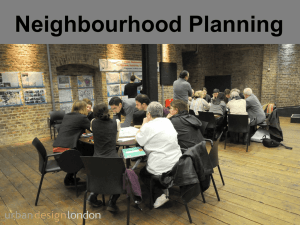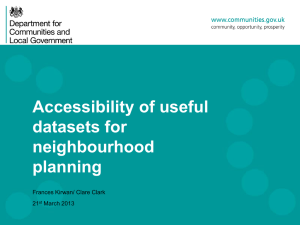Presentation - Neighbourhood Effects
advertisement
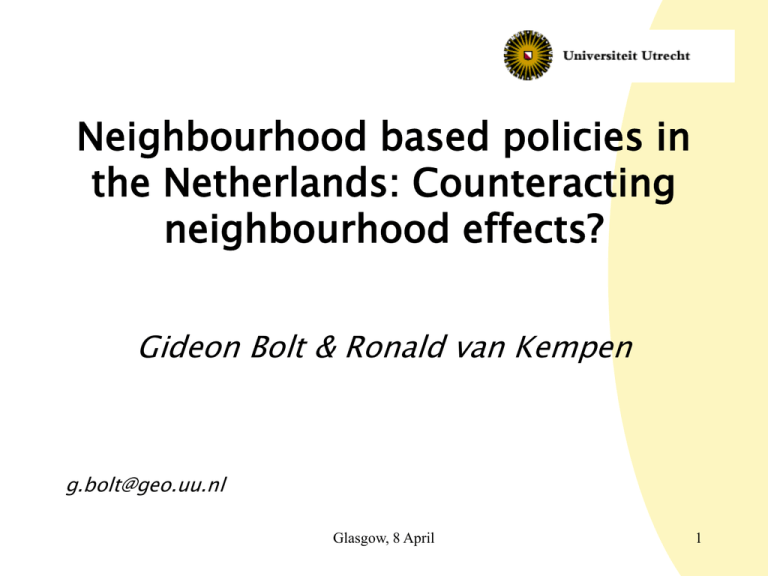
Neighbourhood based policies in the Netherlands: Counteracting neighbourhood effects? Gideon Bolt & Ronald van Kempen g.bolt@geo.uu.nl Glasgow, 8 April 1 Structure • • • • Introductory remarks Methods to create a social mix Housing allocation/ “Rotterdam law” Neighbourhood based policies in the Netherlands • Effects of mixing policies • Conclusions Two main types of desegregation policies I) Mixing people a) Housing allocation b) Mobility programs II) Mixing houses c) Scattered-site programs d) Housing diversification Housing allocation Allocation on income criteria: - Social housing: stricter criteria lead to more income segregation - Blocking strategies for deprived neighbourhoods (Rotterdam) Allocation on the basis of ethnic background. - Not legal anymore in most European countries. Germany is an exception - Many examples of illegal exclusionary policies (e.g. France, Belgium) ‘Rotterdam Act’: What is the problem? Concentration of disadvantaged or of minority ethnic groups? "... Ethnicity or descent is not the main issue. It is the relative wealth and socio-economic position of newcomers and the opportunities in the city for social mobility. In short, the colour is not the problem, but the problem does have a colour " (Municipality of Rotterdam, 2003 p.12). ‘Rotterdam Act’ Law enables municipal governments to exclude people who depend on social security and cannot financially support themselves, and who have not lived in the municipal region in the preceding six years, from the rental housing market in so-called problem areas Effects on segregation very limited Housing diversification Implemented in several European countries, including the Netherlands, Sweden, Denmark, France and the UK. In the Netherlands: often in combination with a large amount of demolition US: HOPE VI program Neighbourhood based policy in the Netherlands Urban renewal in the 1970s and 1980s: - Focus on physical problems - “Building for the neighbourhood Stabilisation of concentration of low incomes Social problems not solved Glasgow, 8 April 2011 8 Neighbourhood based policy in the Netherlands 1997 Memorandum Urban Renewal: One- sidedness of the population is a problem in many urban neighbourhoods -> restructuring policy to promote ‘undivided cities’: - demolition and new construction, particularly in the owner occupied sector - sale of social rented housing - upgrading of dwelling - joining dwellings together Glasgow, 8 April 2011 9 10 11 IP Stockholm 2010 12 Some examples of blocks in Dutch urban neighbourhoods that will be demolished Neighbourhood based policy in the Netherlands • In the course of the last decade, more and more emphasis on the integration of minorities. Yearly Memorandum on Integration Policy (2005): “Concentration is disadvantageous because it makes the ethnic dividing lines more visible in a more concentrated way. That harms the image of ethnic minorities … Finally, concentration is particularly disadvantageous for the possibilities for meeting and contacts between persons from different origin groups…the diminishing contacts with native Dutch indirectly influence the social chances of ethnic minorities.” Glasgow, 8 April 2011 19 Neighbourhood based policy in the Netherlands 2007: New government (Christian and Social Democrats • Since 2007 stronger focus on area-based policy: 40 ‘priority neighbourhoods’ • Minister of Housing, Neighbourhoods and Integration. Integration letter (2009): “By doing things together in district and neighbourhood, citizens will become closer to each other, differences will be less threatening and there will even be more room for diversity. Segregation hinders that. Next to that, it stops the exchange of knowledge about Dutch society and it appears if there is no necessity anymore to command the Dutch language well (…) The Netherlands should not be a country of parallel communities, but should be a country of equal opportunities for everyone”. Glasgow, 8 April 2011 20 Neighbourhood based policy in the Netherlands 2010: Right wing government Bad news for priority neighbourhoods? - Less government investments in priority neighbourhoods - Bullying housing association (taxes, limited increase in rent level) - 90 % of social housing should be allocated to low incomes (< € 33.000) - Higher incomes (> € 43.000) should pay more rent Glasgow, 8 April 2011 21 Effects of mixing policies Two questions: I) Do policies lead to more social mix? II) Does social mix lead to positive outcomes? I) Do policies lead to more social mix? Effects on social mix are often small, because: Targeted number of households and/or houses is too small Policy targeted at a too broad spatial scale (e.g. France) Segregation within social housing sector Policy sometimes ’too succesful’: gentrification instead of socio-economic mix Displaced household move to other poor and/or immigrant dense areas. Policy does not compensatie for locational choices of the ’better off’ (white flight, white avoidance) I) Do policies lead to more social mix? Dutch evidence Table 1: Population changes in urban restructuring neighbourhoods % low income households 1998 % low income households 2003 Difference 1998-2003 % ethnic minorities 1998 % ethnic minorities 2003 Difference 1998-2003 Source: Wittebrood and Van Dijk (2007) Unique neighbourhoods (n=6) 33.0 22.1 - 10.9 51.0 56.6 5.6 Experimental neighbourhoods (n=24) 25.2 16.7 - 8.5 28.0 33.1 5.1 Control neighbourhoods (n=24) 23.0 17.2 - 5.8 26.4 32.8 6.4 I) Do policies lead to more social mix? Dutch evidence Table 2: Segregation indices in Rotterdam, The Hague and Utrecht SI lowest income quintile SI highest income quintile SI Turks and Moroccans Rotterdam The Hague Utrecht 1999 13,3 17,3 11,5 2005 14,4 21,3 13,6 change 1,1 4,0 2,1 1999 28,4 31,0 23,2 2005 28,4 36,7 26,5 change 0,0 5,7 3,3 1999 48,2 51,6 40,8 2005 43,6 52,1 43,1 change - 4,6 0,5 2,3 Table 3: Development SI by neighbourhood type Priority neighbourhoods SI lowest income quintile Rotterdam The Hague Utrecht SI highest income quintile Rotterdam The Hague Utrecht SI Turks and Moroccans Rotterdam The Hague Utrecht New housing estates Restructuring 0.3 2.8 2.6 Other neighbourhoods Other Restructuring Other 0.0 0.7 -0.1 0.5 0.3 -0.3 -0.1 0.2 0.0 0.4 -0.1 0.0 0.9 5.8 3.8 -0.2 0.3 -0.1 0.4 1.2 2.1 -0.4 0.1 0.0 -0.7 -1.7 -2.4 0.3 1.7 1.2 -1.9 -1.5 -0.7 -2.4 1.5 3.1 -0.2 -0.2 0.3 -0.5 -1.0 -1.6 I) Do policies lead to more social mix? Dutch evidence Displacement and segregation: Displaced households are less likely to move to neighbourhoods with a lower share of low-income households or minority ethnic groups Segregation tendencies within category of displaced households Dispersal pattern, from Nieuw-Hoograven Distressed Displacees Other movers Dispersal pattern, from Zuilen-Noord Distressed Displacees Other movers II) Does social mix lead to positive outcomes? The answer to this questions tends to be negative on the basis of 3 types of studies: i. Qualitative (etnographic) studies on working class neighbourhood that stress the positive aspects of concentration. ii. Quantitive studies on neighbourhood effects iii. Evaluation studies of mixing policies II. ii) Quantitive studies on neighbourhood effects • European evidence on neighbourhood effects much more mixed than American evidence • Strong suggestion from the literature that individual characteristics and structural labour market characteristics are far more important for social mobility than neighbourhood variables (Musterd et al., Andersson) • Negative association between ethnic mix and aspects of social capital. Putnam’s construct hypothesis:“Diversity, at least in the short run, seems to bring the turtle in all of us” II. ii) Quantitive studies: Dutch evidence Vision of the Minister is based on the finding that there is a negative effect of ethnic concentration on social ties with native Dutch. BUT: • Methodological shortcomings (omitted-variable problem; selection problem) • Measuring social ties • Overemphasizing the role of the neighbourhood II.iii Evaluation studies of mixing policies Mixing does not lead to integration. Dutch, Swedish, American + British researchers find that there is hardly interaction between ‘old’ and ‘new residents’, because of: role of small-distance interaction socio-economic or cultural differences lead to difference in activity patterns ‘community liberated’ planned length of residence heterogeneity. IP Stockholm 2010 34 35 Gans 1961: The balanced community Architectural and site plans can encourage or discourage social contact between neighbours, but homogeneity of background or of interests or values is necessary for this contact to develop into anything more than a polite exchange of greetings Gans pleads for ‘moderate heterogeneity’: “The relatively greater homogeneity of age and income provides the cultural and social prerequisites which allow people to enjoy their neighbors’ heterogeneity with respect to other, less basic characteristics” Possible drawbacks of mixing • Raising awareness of class differences (Arthurson 2002) (problems from both sides) • Tensions /clash of different lifestyles • Breakdown of social networks • Forced moves • Disinvestment in the existing stock • Decreasing social rented stock: • Blaming the victim/social pathology of the poor • Deflecting attention away from the main causes of the ‘urban problem’ • Knock-on effects: moving the problems around • Paternalism/Ethnocentrism. What if you still want to stimulate social interaction by means of mixing? Ask yourself the following questions 1) At what scale level should I mix? (block, street, neighbourhood, city) 2) What kind of heterogeneity I am aiming for? 3) What kind of social ties (strong, causal) do I want to stimulate 4) How do I create stability? 5) How to enhance the image of the neighbourhood? 6) What kind of design principle may stimulate social interaction? (e.g. New Urbanism) Conclusions • Desegregation policies are not very effective in reducing income or ethnic segregation • Deconcentration effect of urban restructuring is (partly) nullified by selective migration of displaced households. • Housing policies tend to have an upward effect on segregation



